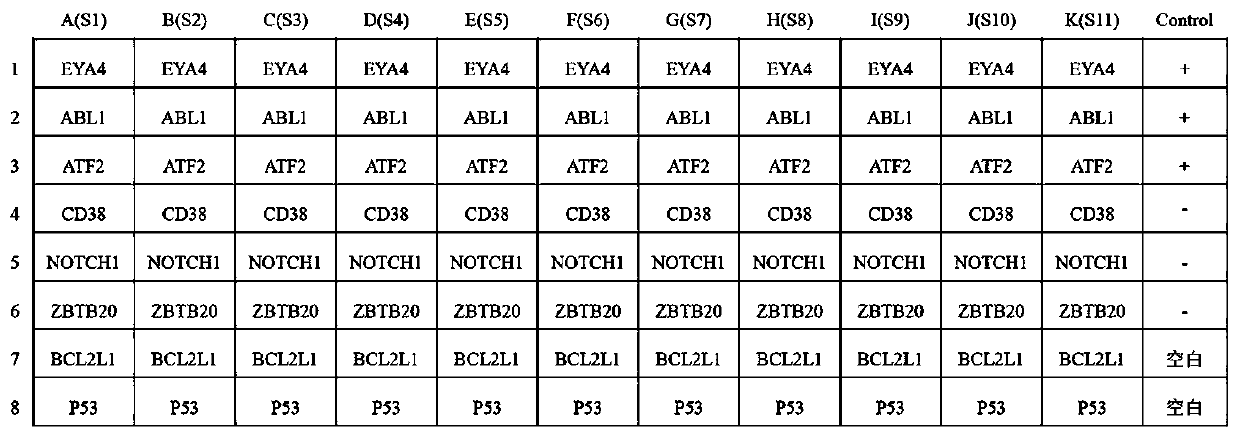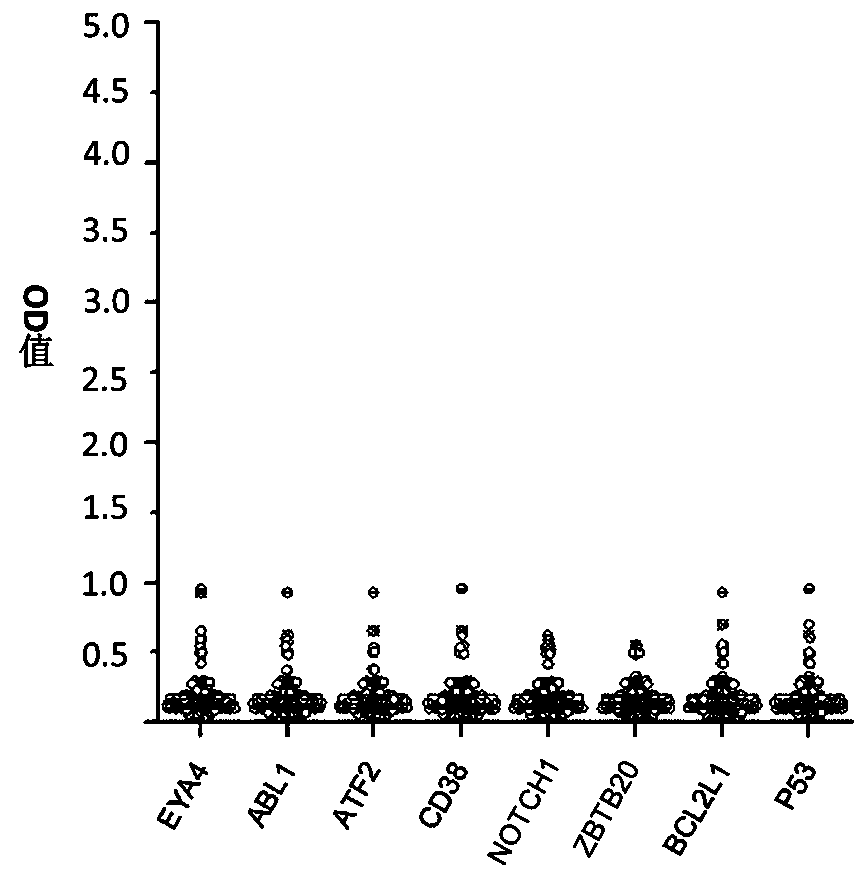Autoantibody joint detection ELISA kit for screening early esophageal cancer
A technology of combined detection of autoantibodies, applied in the fields of molecular biology and oncology, to achieve the effect of high cost performance, increase detection rate, and reduce mortality
- Summary
- Abstract
- Description
- Claims
- Application Information
AI Technical Summary
Problems solved by technology
Method used
Image
Examples
Embodiment 1
[0028] Example 1: Preparation of 8 tumor-associated antigens
[0029] By using a prokaryotic expression system, 8 tumor-associated antigens (EYA4, ABL1, ATF2, CD38, NOTCH1, ZBTB20, BCL2L1, and P53) were prokaryotically expressed and purified to prepare for the next experiment. The specific antigen preparation process is as follows:
[0030] (1) Using gene cloning technology to construct recombinant prokaryotic expression plasmids of 8 tumor-associated antigen proteins (EYA4, ABL1, ATF2, CD38, NOTCH1, ZBTB20, BCL2L1 and P53);
[0031] (2) Expressing the target protein: Transform the constructed recombinant prokaryotic expression plasmids into Escherichia coli BL21(DE3), and use IPTG (isopropylthiogalactopyranoside) to induce the expression of the target protein;
[0032] (3) Purify the target protein: Purify the target protein according to the tag carried by the target protein using a traditional corresponding purification scheme;
[0033] (4) The protein concentration was me...
Embodiment 2
[0035] Embodiment 2: the preparation of kit
[0036] According to the principle of indirect ELISA, the invention prepares an autoantibody joint detection ELISA kit for early esophageal cancer screening. The principle of indirect enzyme-linked immunoassay is to link the antigen to a solid-phase carrier, and the antibody to be tested in the sample combines with it to form a solid-phase antigen-test antibody complex, and then use the enzyme-labeled secondary antibody and the solid-phase antigen-test antibody to The antibodies in the complex combine to form a solid-phase antigen-test antibody-enzyme-labeled secondary antibody complex, and then measure the degree of color development after adding the substrate to determine the content of the antibody to be tested.
[0037] 1. Reagents and materials:
[0038] (1) 8 tumor-associated antigen proteins (EYA4, ABL1, ATF2, CD38, NOTCH1, ZBTB20, BCL2L1 and P53);
[0039] (2) 96-well ELISA plate: purchased from Corning Company;
[0040] ...
Embodiment 3
[0071] Embodiment 3: the detection method of kit of the present invention
[0072] 1. Serum sample incubation:
[0073] Dilute the serum sample to be tested with the sample diluent at a ratio of 1:100, and then add the diluted serum sample to the spotting well of the antigen-coated 96-well microplate plate, and the sample volume is 100 μl / well , placed in a constant temperature incubator at 37°C for 1 h, then discarded the liquid in the spotting well, and washed 5 times with washing solution.
[0074] 2. Enzyme-labeled secondary antibody incubation:
[0075] Dilute the horseradish peroxidase-labeled RecA protein with the secondary antibody diluent at a ratio of 1:8000, and then add the diluted horseradish peroxidase-labeled RecA protein to the 96-well microtiter plate for spotting In the wells, the sample volume was 100 μl / well, placed in a 37°C constant temperature incubator and incubated for 1 hour, then the liquid in the sample wells was discarded, and washed 5 times with...
PUM
| Property | Measurement | Unit |
|---|---|---|
| Sensitivity | aaaaa | aaaaa |
Abstract
Description
Claims
Application Information
 Login to View More
Login to View More - Generate Ideas
- Intellectual Property
- Life Sciences
- Materials
- Tech Scout
- Unparalleled Data Quality
- Higher Quality Content
- 60% Fewer Hallucinations
Browse by: Latest US Patents, China's latest patents, Technical Efficacy Thesaurus, Application Domain, Technology Topic, Popular Technical Reports.
© 2025 PatSnap. All rights reserved.Legal|Privacy policy|Modern Slavery Act Transparency Statement|Sitemap|About US| Contact US: help@patsnap.com



